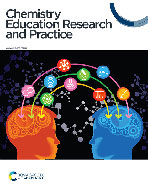了解八元框架:关于 "高中生利用哪些资源将化学反应中的能量变化和结构变化联系起来?- 定性研究
IF 3.2
2区 教育学
Q1 EDUCATION & EDUCATIONAL RESEARCH
引用次数: 0
摘要
最近,《化学教育研究与实践》杂志上的一项研究强调了被称为 "八分框架 "的学生常见思维模式,并指出这种思维模式似乎与八分法则有关,但又不一致,而八分法则是化学入门课程中常用的教学理念。该研究注意到学习者将八分之一规则扩展为化学变化的 "驱动力 "这一共同特征,但分析还注意到替代概念框架的另外两个特征。本文认为,这些研究结果反映了化学教育中的一个关键问题:研究界应优先考虑对该问题进行进一步研究。本文章由计算机程序翻译,如有差异,请以英文原文为准。
Comment on “What resources do high school students activate to link energetic and structural changes in chemical reactions? – A qualitative study” by B. Pölloth, D. Diekemper and S. Schwarzer, Chem. Educ. Res. Pract., 2023, 24, 1153
A recent study in Chemistry Education Research and Practice highlights the common pattern of student thinking known as ‘the octet framework’, and notes how it seems to relate to, but be inconsistent with, the octet rule: an idea commonly taught in introductory chemistry classes. The study noted the common feature of learners extending the octet rule into ‘a driving force’ for chemical change, but analysis also noted two other features of the alternative conceptual framework. It is argued here that these research findings reflect a key problem in chemistry education: one that the research community should prioritise for further investigation.
求助全文
通过发布文献求助,成功后即可免费获取论文全文。
去求助
来源期刊
CiteScore
4.80
自引率
26.70%
发文量
64
审稿时长
6-12 weeks
期刊介绍:
The journal for teachers, researchers and other practitioners in chemistry education.

 求助内容:
求助内容: 应助结果提醒方式:
应助结果提醒方式:


